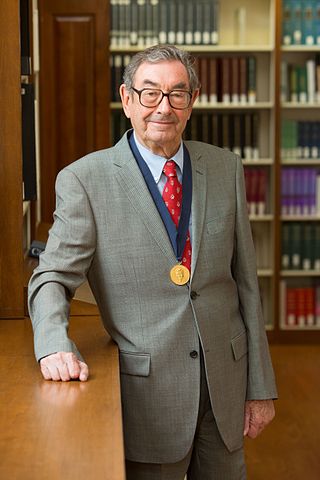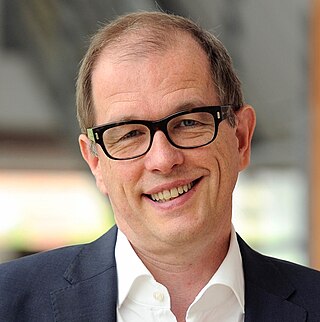Related Research Articles

In chemistry, a hydrogen bond is primarily an electrostatic force of attraction between a hydrogen (H) atom which is covalently bonded to a more electronegative "donor" atom or group (Dn), and another electronegative atom bearing a lone pair of electrons—the hydrogen bond acceptor (Ac). Such an interacting system is generally denoted Dn−H···Ac, where the solid line denotes a polar covalent bond, and the dotted or dashed line indicates the hydrogen bond. The most frequent donor and acceptor atoms are the period 2 elements nitrogen (N), oxygen (O), and fluorine (F).

William Nunn Lipscomb Jr. was a Nobel Prize-winning American inorganic and organic chemist working in nuclear magnetic resonance, theoretical chemistry, boron chemistry, and biochemistry.

Solvation describes the interaction of a solvent with dissolved molecules. Both ionized and uncharged molecules interact strongly with a solvent, and the strength and nature of this interaction influence many properties of the solute, including solubility, reactivity, and color, as well as influencing the properties of the solvent such as its viscosity and density. If the attractive forces between the solvent and solute particles are greater than the attractive forces holding the solute particles together, the solvent particles pull the solute particles apart and surround them. The surrounded solute particles then move away from the solid solute and out into the solution. Ions are surrounded by a concentric shell of solvent. Solvation is the process of reorganizing solvent and solute molecules into solvation complexes and involves bond formation, hydrogen bonding, and van der Waals forces. Solvation of a solute by water is called hydration.
Cubane is a synthetic hydrocarbon compound with the formula C8H8, and that consists of eight carbon atoms arranged at the corners of a cube, with one hydrogen atom attached to each carbon atom. A solid crystalline substance, cubane is one of the Platonic hydrocarbons and a member of the prismanes. It was first synthesized in 1964 by Philip Eaton and Thomas Cole. Before this work, Eaton believed that cubane would be impossible to synthesize due to the "required 90 degree bond angles". The cubic shape requires the carbon atoms to adopt an unusually sharp 90° bonding angle, which would be highly strained as compared to the 109.45° angle of a tetrahedral carbon. Once formed, cubane is quite kinetically stable, due to a lack of readily available decomposition paths. It is the simplest hydrocarbon with octahedral symmetry.
John Joseph Hopfield is an American scientist most widely known for his invention of an associative neural network in 1982. It is now more commonly known as the Hopfield network.

Valence shell electron pair repulsion (VSEPR) theory is a model used in chemistry to predict the geometry of individual molecules from the number of electron pairs surrounding their central atoms. It is also named the Gillespie-Nyholm theory after its two main developers, Ronald Gillespie and Ronald Nyholm.
Iron–sulfur proteins are proteins characterized by the presence of iron–sulfur clusters containing sulfide-linked di-, tri-, and tetrairon centers in variable oxidation states. Iron–sulfur clusters are found in a variety of metalloproteins, such as the ferredoxins, as well as NADH dehydrogenase, hydrogenases, coenzyme Q – cytochrome c reductase, succinate – coenzyme Q reductase and nitrogenase. Iron–sulfur clusters are best known for their role in the oxidation-reduction reactions of electron transport in mitochondria and chloroplasts. Both Complex I and Complex II of oxidative phosphorylation have multiple Fe–S clusters. They have many other functions including catalysis as illustrated by aconitase, generation of radicals as illustrated by SAM-dependent enzymes, and as sulfur donors in the biosynthesis of lipoic acid and biotin. Additionally, some Fe–S proteins regulate gene expression. Fe–S proteins are vulnerable to attack by biogenic nitric oxide, forming dinitrosyl iron complexes. In most Fe–S proteins, the terminal ligands on Fe are thiolate, but exceptions exist.

Electron transfer (ET) occurs when an electron relocates from an atom or molecule to another such chemical entity. ET is a mechanistic description of certain kinds of redox reactions involving transfer of electrons.

In chemistry, pi stacking refers to the presumptive attractive, noncovalent pi interactions between the pi bonds of aromatic rings. However this is a misleading description of the phenomena since direct stacking of aromatic rings is electrostatically repulsive. What is more commonly observed is either a staggered stacking or pi-teeing interaction both of which are electrostatic attractive For example, the most commonly observed interactions between aromatic rings of amino acid residues in proteins is a staggered stacked followed by a perpendicular orientation. Sandwiched orientations are relatively rare.
A solvated electron is a free electron in a solution, in which it behaves like an anion. An electron's being solvated in a solution means it is bound by the solution. The notation for a solvated electron in formulas of chemical reactions is "e−". Often, discussions of solvated electrons focus on their solutions in ammonia, which are stable for days, but solvated electrons also occur in water and many other solvents – in fact, in any solvent that mediates outer-sphere electron transfer. The solvated electron is responsible for a great deal of radiation chemistry.

Harry Barkus Gray is the Arnold O. Beckman Professor of Chemistry at California Institute of Technology.
In chemistry, a halogen bond occurs when there is evidence of a net attractive interaction between an electrophilic region associated with a halogen atom in a molecular entity and a nucleophilic region in another, or the same, molecular entity. Like a hydrogen bond, the result is not a formal chemical bond, but rather a strong electrostatic attraction. Mathematically, the interaction can be decomposed in two terms: one describing an electrostatic, orbital-mixing charge-transfer and another describing electron-cloud dispersion. Halogen bonds find application in supramolecular chemistry; drug design and biochemistry; crystal engineering and liquid crystals; and organic catalysis.
Jay Richmond Winkler, Ph.D. is an American physical chemist, currently director of the Beckman Institute Laser Resource Center at the California Institute of Technology. He has authored over two hundred twenty five articles on applications of inorganic spectroscopy, including the pioneering study of intramolecular electron transfer reactions in biological systems.

Organomolybdenum chemistry is the chemistry of chemical compounds with Mo-C bonds. The heavier group 6 elements molybdenum and tungsten form organometallic compounds similar to those in organochromium chemistry but higher oxidation states tend to be more common.

Eluvathingal Devassy Jemmis is a professor of theoretical chemistry at the Indian Institute of Science, Bangalore, India. He was the founding director of Indian Institute of Science Education and Research, Thiruvananthapuram (IISER-TVM). His primary area of research is applied theoretical chemistry with emphasis on structure, bonding and reactivity, across the periodic table of the elements. Apart from many of his contributions to applied theoretical chemistry, an equivalent of the structural chemistry of carbon, as exemplified by the Huckel 4n+2 Rule, benzenoid aromatics and graphite, and tetrahedral carbon and diamond, is brought in the structural chemistry of boron by the Jemmis mno rules which relates polyhedral and macropolyhedral boranes to allotropes of boron and boron-rich solids. He has been awarded Padma Shri in Science and Engineering category by the Government of India.
Robert Tycko is an American biophysicist whose research primarily involves solid state NMR, including the development of new methods and applications to various areas of physics, chemistry, and biology. He is a member of the Laboratory of Chemical Physics in the National Institute of Diabetes and Digestive and Kidney Diseases at the National Institutes of Health in Bethesda, Maryland, USA. He was formerly a member of the Physical Chemistry Research and Materials Chemistry Research departments of AT&T Bell Labs in Murray Hill, New Jersey. His work has contributed to our understanding of geometric phases in spectroscopy, physical properties of fullerenes, skyrmions in 2D electron systems, protein folding, and amyloid fibrils associated with Alzheimer’s disease and prions.
Nenad Trinajstić was a Croatian chemist and one of pioneers of the chemical graph theory.

David Lyndon Emsley FRSC is a British chemist specialising in solid-state nuclear magnetic resonance and a professor at EPFL. He was awarded the 2012 Grand Prix Charles-Leopold Mayer of the French Académie des Sciences and the 2015 Bourke Award of the Royal Society of Chemistry.

Stephen L. Craig is the William T. Miller Professor of Chemistry at Duke University. He is the director of the Center for Molecularly Optimized Networks, a NSF Center for Chemical Innovation.
Michael J. Therien is the William R. Kenan, Jr. Professor of Chemistry at Duke University.
References
- ↑ "Duke Chemistry". Duke University Chemistry. Retrieved 27 June 2019.
- ↑ "Duke Physics". Duke University Physics. Retrieved 27 June 2019.
- ↑ "Duke Biochemistry". Duke University Biochemistry. Archived from the original on 10 July 2019. Retrieved 27 June 2019.
- ↑ "Award Abstract 1925690" . Retrieved 17 July 2019.
- ↑ "Academic Family Tree – John Hopfield". Neurotree - Hopfield. Retrieved 9 July 2019.
- 1 2 3 4 "Guggenheim Fellow Biosketch". Guggenheim Fellows. Retrieved 9 July 2019.
- ↑ Beratan, Betts, Onuchic (1991). "Protein electron transfer rates set by the bridging secondary and teriary structure". Science. 252 (5010): 1285–1288. Bibcode:1991Sci...252.1285B. doi:10.1126/science.1656523. PMID 1656523.
- ↑ Marder, Beratan, Cheng (1991). "Approaches for Optimizing the First Electronic Hyperpolarizability of Conjugated Organic Molecules". Science. 252 (5002): 103–106. Bibcode:1991Sci...252..103M. doi:10.1126/science.252.5002.103. PMID 17739081. S2CID 39158497.
- ↑ Priyadarshy, Risser, Beratan (1996). "DNA is not a molecular wire: protein-like electron-transfer predicted in an extended pi-electron system". J. Phys. Chem. 100 (44): 17678–17682. doi:10.1021/jp961731h.
- ↑ Kuhn, Beratan (1996). "Inverse Strategies for Molecular Design". J. Am. Chem. Soc. 100 (25): 10595–10599. doi:10.1021/jp960518i.
- ↑ Kondru, Wipf, Beratan (1998). "Theory-Assisted Determination of Absolute Stereochemistry for Complex Natural Products via Computation of Molar Rotation Angles". J. Am. Chem. Soc. 120 (9): 2204–2205. doi:10.1021/ja973690o.
- ↑ Zhang, Liu, Balaeff, Skourtis, Beratan (2014). "Biological charge transfer via flickering resonance". PNAS. 111 (28): 10049–10054. Bibcode:2014PNAS..11110049Z. doi: 10.1073/pnas.1316519111 . PMC 4104919 . PMID 24965367.
- ↑ Skourtis, Waldeck, Beratan (2004). "Inelastic electron tunneling erases coupling-pathway interferences". J. Phys. Chem. B. 108 (40): 15511–15518. doi:10.1021/jp0485340.
- ↑ Wang, Hu, Beratan, Yang (2006). "Designing molecules by optimizing potentials". J. Am. Chem. Soc. 128 (10): 3228–3232. doi:10.1021/ja0572046. PMID 16522103.
- ↑ Virshup, Contreras-Garcia, Wipf, Yang, Beratan (2013). "Stochastic voyages into uncharted chemical space produce a representative library of all possible drug-like compounds". J. Am. Chem. Soc. 135 (19): 7296–7203. doi:10.1021/ja401184g. PMC 3670418 . PMID 23548177.
- ↑ "Beratan Lab".
- ↑ "Google Scholar" . Retrieved 8 July 2019.
- ↑ "Bourke Award 2019" . Retrieved 10 July 2019.
- ↑ "Murray Goodman Memorial Prize 2018". 5 November 2018.
- ↑ "Florida Award 2017".
- ↑ "Herty Medal 2015". Archived from the original on 2019-07-10. Retrieved 2019-07-10.
- ↑ "Feynman Prize 2013". Archived from the original on 2019-07-10. Retrieved 2019-07-10.
- ↑ "Hirschmann Visiting Professorship".
- ↑ "NSF Young Investigator: Electron Transfer in Complex Systems".